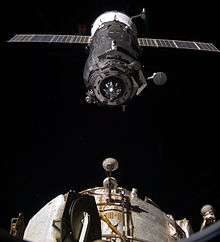Kurs (docking navigation system)

Kurs (Ukrainian and Russian: Курс, Course) is a radio telemetry system used by the Soviet and later Russian space program.
Kurs was developed by the Research Institute of Precision Instruments (NII TP, Russian: НИИ Точных Приборов) before 1985[1][2] and manufactured by the Kiev Radio Factory (Ukrainian: Київський Радіозавод).[3]
History
Kurs was the successor to the Igla system and today provides navigation beaconing for Russian space vehicles including the Soyuz spacecraft and Progress spacecraft. Kurs provided the automated docking system for all Russian spacecraft that docked with the Mir space station. [4][5] When used for docking, the Soyuz or Progress vehicle broadcasts radar pulses from multiple antennas. The variation in strength between the antennas allows the system to compute relative position, attitude, and approach rate. The system is designed for automatic rendezvous and docking, but in an emergency cosmonauts may take command of the vehicle either locally, or from the International Space Station.[6]
After the dissolution of the Soviet Union in 1991, the Kurs system became the property of Ukraine; its manufacturer became a competitor in the space launch business with the Russian Federal Space Agency (RKA). Due to hard-currency problems, Kiev also raised the price of the Kurs system. Consequently, RKA sought to phase out its use in its vehicles.[7]
Kurs-NA
The Kurs-NA (Russian: Новая Активная, New Active) docking system, requiring only one rendezvous antenna, is replacing Kurs-A, which required five, and will use less power.[8] It was tested by Progress M-15M in July 2012[8] and by Progress M-21M in November 2013.[9]
ISS
ATV
The now Russian-built antenna part of the Kurs system also served as an independent and redundant docking monitoring system for the European Automated Transfer Vehicle.[10] It served as an additional monitoring system and could not be used to control the approach or docking of ATV in any way.[11]
Failures
On 15 December 2015 during the docking of Soyuz TMA-19M with the International Space Station the Kurs system mis-aligned the spacecraft and failed to dock, requiring a manual docking approach piloted by Soyuz Commander Yuri Malenchenko. This delayed the docking by 10 minutes.[12]
See also
- TriDAR, a relative navigation vision system used on three Space Shuttle flights to the ISS
References
- ↑ NII TP history (in Russian)
- ↑ "History". Research Institute of Precision Instruments (NII TP). Retrieved 12 October 2008.
The first automated docking of “Mir” orbital station with “Soyuz-TM-1” spacecraft was implemented on May 23, 1986 by means of the “Kurs” equipment. [..] "Kurs-ММ" docking system for short-range spacecraft has been designed for the upgraded spacecraft under the ISS program [..] “Kurs-M” radio-electronic system for “Kurs-ATV”, for monitoring of rendezvous and docking ATV- spacecraft (European Space Agency) with the ISS on range and radial velocity
|chapter=ignored (help) - ↑ "The First Serially Produced Onboard Computer". The European Virtual Computer Museum. The History of Development of Computer Science and Technologies in Ukraine. Retrieved 12 October 2008.
The production association Kiev Radio Factory aimed its further development toward the production of equipment for space exploration. In 1966 it started the production of a unique onboard complex named Igla for search, mutual orientation, approach and docking of space vehicles. [..] In 1985 the Igla was succeeded by the Kurs, a more advanced and reliable system, which is working now on the Mir-Soyuz-Progress complex.
- ↑ Burrough, Bryan (1998). Dragonfly: NASA and the Crisis Aboard Mir. Fourth Estate. p. 65. ISBN 0-06-093269-4.
Since 1985 all Russian spacecraft had used the Kurs computers to dock automatically with the Mir station [..] All the Russian commanders had to do was sit by and watch.
- ↑ National Space Agency of Ukraine / Kurs Research and Production Complex, Public Company
- ↑ Hinman, Elaine M; Bushman, David M. (1991). "Soviet automated rendezvous and docking system overview". NASA Automated Rendezvous and Capture Review.: 34–35. Bibcode:1991arcr.nasa...34H.
IGLA system was replaced with the current KURS system. Both systems are radar-based. [..] the docking process can be controlled either from the ground or from the active (docking) spacecraft's onboard computer. [..] Soyuz TM and Progress M Series spacecraft incorporated the KURS. The MIR Complex has both systems installed.
|chapter=ignored (help) - ↑ Linenger, Jerry (January 1, 2001). "Off the Planet: Surviving Five Perilous Months Aboard the Space Station Mir". New York, USA: McGraw-Hill. ISBN 978-0-07-137230-5
- 1 2 Harding, Pete (28 July 2012). "Progress M-15M re-docks to ISS following resolution of Kurs-NA failure". NASASpaceFlight (not associated with NASA). Retrieved 1 September 2012.
- ↑ Космический грузовик «Прогресс М-21М» испытал систему сближения с МКС
- ↑ Integrated cargo carrier Figure 2-3: External Equipment on the EPM Front Cone
- ↑ "Safety and autonomy make the ATV unique". European Space Agency. 12 October 2005. Retrieved 1 September 2012.
the crew members cannot manually pilot the ATV by remote control
- ↑ "Tim Peake begins stay on international space station".